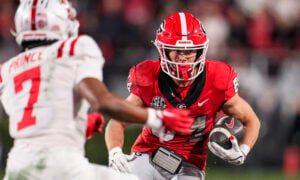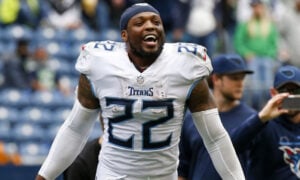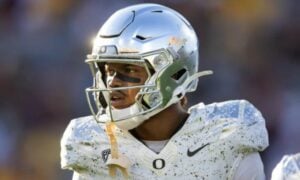2012 NFL Draft Preview
 We’re half way (approximately) through the NFL season and it’s quite likely you’re either looking forward to a championship run … or to the 2012 NFL Draft. While we wish you luck with your championship pursuit, this article is not for you. For those of you to whom the remaining nine games equate to nothing more than an exercise in patience and/or futility, and hopefully sportsmanship, allow us to lift your spirits just a bit with a quick look at the top five 2012 would-be rookies within each of the three major positions as I have them currently ranked.
We’re half way (approximately) through the NFL season and it’s quite likely you’re either looking forward to a championship run … or to the 2012 NFL Draft. While we wish you luck with your championship pursuit, this article is not for you. For those of you to whom the remaining nine games equate to nothing more than an exercise in patience and/or futility, and hopefully sportsmanship, allow us to lift your spirits just a bit with a quick look at the top five 2012 would-be rookies within each of the three major positions as I have them currently ranked.
But first, just a short bit of commentary about the 2012 draft.
Currently, I give the following grades to the skill positions of 2012:
Quarterback – A
Running Back – C
Wide Receiver – B
As I’ll explain once I get into the individual positions, 2012 just isn’t shaping up as a very deep fantasy-productive class, at least not out of the gate. While every year future gems are to be found in rounds beyond the first in fantasy drafts, trying to identify those players up front is somewhat of a fool’s errand. But that won’t stop us from giving it the ol’ college try!
Quarterback
The 2012 crop of quarterbacks looks to be an impressive bunch. Where last year’s rookies left me largely underwhelmed, at least before Cam Newton surprised most everyone, the 2012 class is full of first round talent. By all accounts, a quarterback said to be a “once in a decade” and even perhaps “once in two decades” player will here is name called first unless hell has frozen over.
1. Andrew Luck, Stanford
Junior
6’4″/235 Lbs.
Announcing the first pick in the 2012 draft is likely just a formality as it currently stands. Stanford’s Andrew Luck is as coveted as they come, most saying he’s the best prospect to emerge from college since Peyton Manning in 1998 and others more boldly exclaiming that he’s the best since John Elway. Either way, unless Luck channels his inner Jake Locker and elects to finish out his senior season at Stanford, he’ll without question be the first pick off the board.
There has been talk that Luck’s father may be interfering with the draft process and urging Luck to pull an Eli Manning, essentially declaring ahead of time who he would or would not play for in the NFL. While I understand the reasoning for such action, I do hope it is just early talk with no basis in fact. I have a very high opinion of Andrew Luck and would be extremely disappointed to see a replay of the Eli Manning fiasco.
If there is one scenario on the board that could see Luck falling as the first pick, it’s if the Colts should find themselves on the clock at 1.01. Inside word has it that the Colts would not select Luck with the first pick of the draft, but I find that very hard to believe given Manning’s injury status and advancing age. Some have said that the odds are against Manning returning at any point, let alone in 2012. It’s also been said that because of the depth of this year’s quarterback class, it isn’t likely that needy clubs would be willing to trade up to land Luck, another opinion that I don’t necessarily buy into just yet.
Either way, Luck is as much a talent as any I have seen come out of college. Having watched him for two years now and very closely in 2011, I’m convinced that the experts are dead on about Luck. He has a ridiculous 71.9% completion percentage and an equally ridiculous 23:4 TD:INT ratio. True that Stanford’s offensive line is huge and very adept, but Luck is polished, poised and strikingly accurate.
I don’t say this lightly as it relates to fantasy. But in 2012, Luck is your first pick off the board almost regardless of who is piloting your team currently. He’s that good and represents the possibility of being your quarterback for the next 15 years. He’s as much a sure thing as there has been in the last decade or more.
2. Landry Jones, Oklahoma
Junior
6’4″/229 Lbs.
Landry Jones represents what nearly every NFL club is looking for in a face for a franchise. Tall, accurate and with a live arm, Jones can easily make all the throws at the NFL level and brings an ample combination of confidence and leadership. Jones isn’t terribly elusive but is quicker than his stats would suggest and does have some level of escapability.
If I have a criticism of Jones, it is in two areas. Firstly, he doesn’t throw what I consider to be a “pretty” ball. He doesn’t consistently spin it well. Instead, the ball flutters from his hand which will affect his accuracy on deeper balls. That said, Jones also outshines all other quarterbacks in this listing in passing yardage, so let’s not go overboard.
Lastly, Jones tends to get sloppy when he’s rushed or is feeling pressure. Not pressure in the way of the pass rush but in the pressure of a game due to circumstance or due to a particularly pressing rush play after play. In situations such as these you can see Jones pressing which immediately shows up in his footwork, especially in his drops.
Regardless of the criticisms, Jones will hear his name called early in the first round in a draft filled with teams hungry for quarterback talent.
3. Matt Barkley, USC
Junior
6’2″/220 Lbs.
Barkley has made phenomenal progress from this time last year. In 2010, I wondered aloud if Barkley would be a first day pick at all, thinking he could slide to the second or third round should he decide to come out in 2012. I’m not sold that Barkley will declare for the 2012 draft but with a draft expectation clearly in the first round, he simply has too much to lose in returning to school. I’ve said that before (Matt Leinart, Brian Brohm and Jake Locker), too. And in most every case, lost money and draft position was the result.
Most notably, Barkley has improved significantly in the areas of confidence and completion percentage. Much like Landry Jones above, Barkley is not overly elusive but can flow from the pocket somewhat smoothly. I question his arm strength for the deeper balls but I like his high release point and quick delivery. He delivers the ball with velocity and accuracy in the short and intermediate routes. Barkley will easily surpass his stats from 2010 and should be a top twenty pick in 2012.
At a a questionable 6’2″, I will anxiously be watching for the official measurement. Anything shorter than 6’2″ will likely drop his status significantly.
4. Nick Foles, Arizona
Senior
6’5″/240 Lbs.
The huge Foles will likely fall to the second round of the NFL draft, but I have him clearly ahead of my #5 quarterback below and as a borderline first round talent. If ever a player’s draft stock was affected by the team around him, Foles is he.
Foles is your prototypical bigger NFL quarterback who stands tall in the pocket with a strong arm. He possesses a quicker release than I expected and shows good pocket presence. In watching Foles mature from 2010, it’s that pocket presence and poise that I note as significant improvements. When Foles is pushed from the pocket, he does well flowing to his right while keeping his eyes down-field awaiting his receivers to uncover.
I’d like to see more deep ball accuracy with Foles but given Arizona’s roster in 2010 and 2011, that may be playing a role. Foles will easily surpass 3,000 yards and, like Andrew Luck above, currently sports a 70% completion rate. Where many experts had Foles as a late round selection in 2010 should he have come out, Foles intelligently decided to return for his senior year and has significantly boosted his draft stock as well.
5. Robert Griffin III, Baylor
Junior
6’1″/220 Lbs.
Michael Vick anyone?
Similarly sized to Michael Vick, Griffin doesn’t possess the vision or pure speed that Vick displayed. That hasn’t stopped Griffin from becoming a notable dual threat, however. Unlike Vick, Griffin sports a 75.4% completion percentage which is an improvement over 2010’s impressive 67% completion percentage. Toss in a 23:4 TD:INT ratio and you have a quick, elusive but accurate quarterback that could do significant damage at the next level.
Most have Griffin solidly in the first round but I first need to see him complete his 2011 campaign and do a more complete review of the competition he has faced thus far. Griffin still seems to struggle, at least to some degree, against better competition. Should he finish 2011 on a high note and should his physical measurements not drop from those listed, Griffin will indeed likely here his name called on day one of the NFL draft. I’ll stick by my belief though that Foles makes a better NFL prospect at this point in their respective games.
Running Backs
There’s a lot of risk in next year’s rookie running back crop. That’s not to say that there isn’t talent available, but it’s a position that, again, will be difficult to judge talent-wise out of the gate. Much as I expect the best running back from 2010 to be potentially a back from the lower-first or second round of fantasy drafts (Kendall Hunter, DeMarco Murray, etc.), 2012 could be of that same level of quality.
If there is one thing I do like about the would-be rookies in 2012, it’s their size. My “perfect” size of running back is 5’11” and 218 lbs. Many of this next year’s backs are in that range. No back in this group should eclipse Andrew Luck as the first pick unless a team is overtly running back poor and quarterback rich.
1. Trent Richardson, Alabama
Junior
5’11″/224 Lbs.
Richardson is the class of the draft without question. Strong, thick and with move-the-pile leg drive, Richardson’s size and build make him an easy selection as the first back off the board. Even more than his size, I like his work ethic and character. Richardson seems to not be happy with just “good enough” and is always looking for more impact, whether it be on the field or in the weight room.
Another key area of technique in Richardson’s style is his wide base. You can see it in nearly every play. He’s got a very strong and wide base and is not easily brought down unless the defender is squared up, even then multiple defenders are normally required. Richardson is also sneaky fast and his timed 40 will be watched closely.
His area of strength also is his area of concern on my sheet. His wide base and style make him less elusive through the hole and he relies on a change of direction or angles in order to break tackles. What he lacks is jump-cut agility and he won’t make many NFL caliber “first to” defenders miss. He’ll need running lanes to exploit at the next level. As tough as Richardson runs, he does seem to leave some yardage on the field and he’s not as productive as his size and ability would suggest. This may be an unfair criticism but it is tangible in my mind from tape that I have watched.
Richardson will likely be a top 10 pick in 2012 and I do not see him returning for his senior year.
2. Chris Polk, Washington
Junior
5’11″/222 Lbs.
Polk is an NFL caliber running back at every glance. He has tremendous leg drive, is always moving forward and gets to top speed very quickly. That top speed is a bit of mystery and he is sneaky fast and I have a hard time pinning down an expected 40 time. My guess would be in the 4.52 range but it is a deceptive speed due to his stride. Teammates suggest a time in the 4.3s but I’ll believe that when it is seen. With nice lateral mobility and fantastic balance, Polk excels at yards after contact, rarely brought down by the first defender.
I like backs that show the ability to increase their yards per carry average year over year. Polk has accomplished just that and will likely put up a career high in rushing yards (1,415) and is certain to eclipse his career high in touchdowns (9) by a good margin. Polk also possesses NFL caliber hands out of the backfield.
Polk will flirt with 800 total collegiate carries as 2011 comes to a close so he does have some mileage on those productive legs. With a good combine performance, he could rise into the bottom half of the first round to a team such as Atlanta or Cincinnati but more than likely he’ll be an early second round selection.
3. Lamar Miller, Miami
Red Shirt Sophomore
5’11″/222 Lbs.
After Richardson and Polk, the next three backs are very close in value . I give a slight edge to Miller here at #3 due to his size, youth and production. Miller is very much a downhill runner and is a bit stiff in the hips which doesn’t provide a lot of lateral mobility. He gets to top speed quickly but his top speed is suspect.
Again nearly averaging 6.0 ypc., Miller has shown enough to already be considered a top prospect. One concern has been Miller’s declining performance over the past three games, showing that conditioning will likely need to be improved. As a red shirt sophomore, Miller’s younger status and lack of mileage will appeal to NFL scouts looking for a workhorse back with upside. While no lock to return for his junior season, as long as his projected selection remains in the first round, I expect that Miller will declare.
4. LaMichael James, Oregon
Junior
5’9″/185 Lbs.
LaMichael James is a tough running back to place. Anyone that has followed my draft advice over the years understands that I begin to knock off points when backs fall below 5’10”, history just isn’t on their side. Below 195 lbs. and even more points are lost. One or the other call into question a back’s ability to be a fantasy producer at the NFL level, both make production a rarity altogether.
For Oregon’s James, I’m making a bit of an exception partially due to his extreme dynamic but also due to the lack of better prospects to rank above him. James runs tougher than his size would suggest and he’s electric in any amount of space. Equally adept in the passing game, and with the success of other such undersized NFL players as Darren Sproles, James has a chance to be ultra productive in an offense with a power back and a stout offensive line.
More recently, injury issues have again shown up with James which raises further red flags as to his ability to stay healthy. No back is more of a mystery when it comes to predicting round selection. My guess would be in the early second round.
5. Montee Ball, Wisconsin
Junior
5’11″/214 Lbs.
Ball hasn’t graced many lists as of yet and I believe many are missing the boat on him in 2011. Most seem to see Ball as overly one-dimensional. But within that single dimension is a tough downhill runner that has surprising quickness, excellent stability and patience. Ball is at his best when moving laterally and allowing his blocks to set up before squaring his pads and getting small through the hole.
Not overly fast and with questionable receiving skills, Ball will need to add weight and dimension to be a producer at the next level but he’s got the work ethic and body type that should play in his favor. Ball is the type of back that will likely slip come draft day, perhaps as far as the third round.
Wide Receivers
The 2012 receiver class is an interesting group and should provide for some nice value picks below pick 1.05 in fantasy drafts. There’s enough size, speed and ability to make ranking beyond the obvious top spot somewhat problematic. If you are picking in the 8-12 area in your 2012 fantasy draft and are in need of a receiver, this is a good group to take advantage of.
1. Justin Blackmon, Oklahoma State
Junior
6’1″/215 Lbs.
To watch Blackmon on tape, you’d swear he was much bigger than his listed 6’1″ height. He has supreme confidence in his hands and he’s nearly impossible to cover one on one. On crossing routes, his long strides and speed make him extremely dangerous and his physicality and agility after the catch are unrivaled in 2011. If not for a few minor lapses in concentration and perhaps another inch or two of height, Blackmon could be considered the next Calvin Johnson.
I’ll be extremely curious to see Blackmon’s official measurements at the combine and I fully expect that he won’t be returning to Oklahoma State for his senior year. He’s a lock to be chosen in the top 10 of the 2012 draft and the Rams would be wise to ensure they are the ones to land him.
2. Michael Floyd, Notre Dame
Senior
6’3″/224 Lbs.
I expect Floyd to be a better pro receiver than he was in college. A big, smooth athlete, Floyd is a good leaper and is dynamic with the ball in his hands. Not particularly physical before the catch, Floyd may have difficulty at the next level getting off jams at the line. Additionally, Floyd too often shows overconfidence in his catching ability and sometimes is lazy with his hands and hand position when not facing the ball (over the shoulder).
The area of greatest concern will be the off the field alcohol issues that Floyd is compiling. If he can’t convince NFL brass that he has matured beyond the need or desire to party with a bottle, he could be in line for a significant fall on draft day. As is, he’s likely a mid first round selection.
3. Alshon Jeffery, South Carolina
Junior
6’4″/229 Lbs.
Jeffery is a talent with a lot of room for growth, which is scary for the 6’4″ 229 lb. specimen. Jeffery shows nice ability to climb the ladder and is tough to bring down in the open field. 2011 hasn’t been the banner year that Jeffery expected following a sophomore season that saw him notch 88 receptions and an impressive 1,517 yards. South Carolina’s quarterback play has been anything but stellar and Jeffery has looked unengaged at times.
Nitpicking further, Jeffery sometimes appear to be lazy in route running. Whether this is due to the sub-par quarterback play mentioned earlier or some other reason, the drop off in production is noteworthy and could lead to a small downgrade in draft status. There’s no questioning his raw ability and huge physical frame which surely will entice many NFL clubs looking for a physical WR1. His draft status will likely be determined by the combine interview process and his answer to the question “How would you explain 2011’s decline in production?” Be very careful of that question young Jeffery. The answer calls for a lot of accountability and a fierce desire to learn from mistakes and not explaining away the drop by pointing out poor quarterback play.
Jeffery will likely still be a middle to late first round selection on raw talent alone.
4. Ryan Broyles, Oklahoma
Senior
5’10″/188
Undersized receivers don’t normally score highly in my rating system. However, show me a receiver that plays much bigger than his listed 5’10” size and with an undeniable dynamic (think Percy Harvin) and I’m willing to keep watching. Broyles is every bit a dynamic NFL talent in waiting. Very quick off the line of scrimmage, electric in the open field and a clean route runner, Broyles is as dangerous underneath as he is over the top. Likely a slot receiver at the next level, there will be many other uses for Broyles for a creative coordinator.
Broyles will likely fall out of the first round due to size concerns and perhaps some lingering doubt stemming from his freshman year arrest for stealing gas, but he has matured and has taken on a leadership role with the Sooners.
5. Rueben Randle, LSU
Junior
6’4″/208 Lbs.
The fifth receiver in this preview is completely up in the air but Randle is rising on my list due to his size, physicality and use of good body leverage. He consistently catches the ball away from his body and shows amazing quickness off the line for a receiver of his size. He has shown some degree of laziness on some routes requiring him to square up to his quarterback, but that can easily be correct over time.
Randle is no lock to remain as my #5 receiver on this list with other such names as Nick Toon and Jeff Fuller vying for the spot, but heading into the final four games of 2011, it’s his to lose.
Randle is likely a middle to late second round selection should he finish the 2011 campaign with a consistent level of production.
In the near future, I will be spending more time within each position, expanding them accordingly. Every year there are surprising risers and fallers from this exercise and following the combine and we’re committed to making sure you don’t miss the smallest detail that can make for a third or fourth round gem of a draft pick (Greg Jennings).
Have your own questionsor thoughts on a player? Use the comment box below to chime in!
- Lineup Advice: Wrap-up, Thank You and Goodbye (TTFN) - January 1, 2024
- Lineup Advice: Week 17 – Championship Edition - December 26, 2023
- Lineup Advice: Week 16 – The “What is” Edition - December 19, 2023


































































